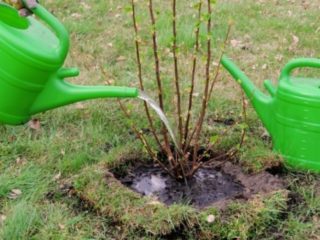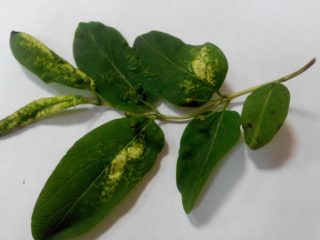Content
The method of propagation of honeysuckle by cuttings is considered one of the most popular. Only the method of dividing the bush competes with it, but it has its drawbacks. With this type of reproduction, the entire plant is exposed to stress. If the procedure is performed incorrectly, the berry can die. Reproduction by cuttings is completely safe for the mother bush. Cutting branches will not kill the plant.
Features of planting honeysuckle cuttings
The popular breeding method for edible honeysuckle has its own characteristics. You need to know them for the process to complete successfully. First of all, it is important to choose cuttings that have the best survival rate. These include segments of twigs taken from honeysuckle during the beginning of fruiting. Moreover, for breeding, they are always chosen by the young, which are the growth of this year.
The term for harvesting the highest quality materials depends on the climate of the region and the variety of honeysuckle. In a late culture, ripening of berries begins in early July. Early varieties delight with their harvest in the first decade of June.
Summer cuttings are called green, since their bark has not yet matured to brown. You can reproduce the culture with lignified twigs, but they are harvested in late autumn or spring before bud break. There is also a third option. It provides for the cutting of honeysuckle edible in summer, but the branches are harvested in combination. The shoot is cut so that one part of it has green bark, and the other is lignified.
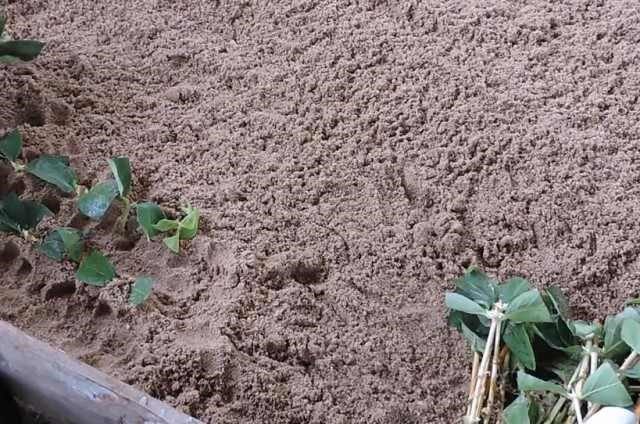
Cut green cuttings are rooted immediately
The popularity of the method of rapid reproduction is also explained by the possibility of preserving the variety you like and getting free seedlings. It is enough to ask friends to cut a dozen cuttings from different honeysuckle bushes and root them immediately in the open ground or in a box with a substrate.
However, if there is a shortage of breeding material, it is better to do it in another way. If you managed to get several branches, then for maximum savings it is better to root them in separate containers. The popularity of the breeding method is explained by the following facts:
- If it gets colder outside, the pots of seedlings can be moved indoors or in a greenhouse. During the heat, the plantings are brought into the shade.
- There is no need to closely monitor soil moisture. In the garden bed, the soil dries out quickly in hot summer, which is dangerous for cuttings. The soil in the flower pot keeps moisture longer.Advice! Germination of freshly cut green cuttings can be done in water. Then there will be no problems with watering at all.
- A rooted honeysuckle seedling from a separate container is easier to plant in open ground. The root system is not injured in the plant, which contributes to better survival.
The method of growing honeysuckle from cuttings is simple for the gardener and does not require any costs. If the reproduction did not work for the first time, the next season you can still cut the branches, try to root them.
How to breed honeysuckle cuttings
Having decided on this method of reproduction, the gardener should know that it is easier to do this in the spring. If there was no opportunity, then in the summer and, finally, in the fall. The principle is almost the same, but there are some nuances.They are associated with the extraction of cuttings, storage and rooting.
Video example of breeding technology:
How to propagate honeysuckle by cuttings in spring
There are three options for breeding a berry in the spring:
- lignified brown cuttings, harvested in the fall;
- lignified brown cuttings cut from honeysuckle in the spring before the buds swell;
- green fresh shoots cut in late spring or early summer.
The first two options are also suitable for autumn breeding, so they will be considered later. Now it is worth getting acquainted with the rooting of green shoots.

The green tops of the twigs are harvested for reproduction after the end of the flowering of the honeysuckle
In warm southern regions, early varieties of honeysuckle with green shoots can be propagated from late spring. The shrub should already bloom and begin to form berries. Before harvesting cuttings, the vine is checked for maturity. When bent, the green twig should break easily.
With cut green twigs, only the middle part is left. The lower cut is made oblique at an angle of 45 °, and the upper cut is made straight 1.5 cm higher from the bud. The lower leaf on the shoot is removed, and the rest are shortened to half.
In this form, it is difficult to plant honeysuckle with a twig directly into the open ground. First, the cuttings require rooting. Do this in water or soil. When choosing the second option, a substrate is prepared from 3 parts of sand and 1 part of peat. If desired, the soil mixture is bought in the store. Sometimes it is replaced with perlite or vermiculite.
The prepared substrate is loaded into flower pots and abundantly moistened. The cuttings are dipped in the bottom of the soil, covered with foil, cans or cut PET bottles to create a greenhouse. All over the seedlings are kept at a temperature of 20-25 ° C. After about 1.5 weeks, the cuttings should take root. They can be planted immediately or left to grow until next spring in a home or greenhouse.
How to root honeysuckle with cuttings in summer
In cold regions, it is better to breed the berry in the summer. There are two options here. The first is to cut the honeysuckle with green cuttings and try to root it as discussed above. The second option involves preparing combined shoots. These branches have a green upper part and a lignified lower part. Cut off cuttings with one or two lateral shoots.
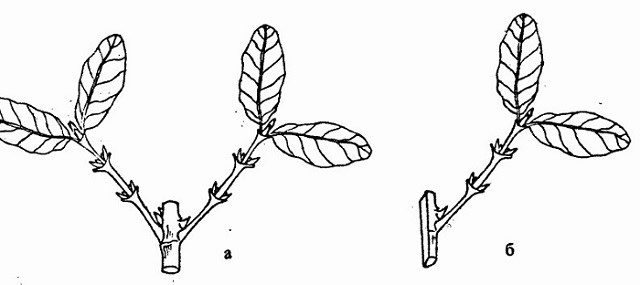
The combined cutting may have one or two green lateral shoots.
The use of combined cuttings has two great advantages. First, according to statistics, the survival rate of such material is 30% higher than that of lignified shoots. Secondly, the green part of the twig contributes to almost 100% rooting of the lignified part under favorable conditions.
Cuttings are done after flowering. The branch is cut so that the lignified part of the green shoot from below remains about 2 cm long. The workpieces are immersed in the prepared substrate to a depth of 3-5 cm, and a greenhouse is arranged. The soil is kept moist at all times. Rooting will take place after about 15 days. Strong honeysuckle seedlings from summer combined cuttings cannot be grown. Until the spring of next year, they are grown indoors.
How to propagate honeysuckle by cuttings in the fall
With the onset of autumn, gardeners stock up on lignified twigs for further propagation of the berry. It is important to define the timing correctly here. Carrying out cuttings of honeysuckle in the summer after the berries is unreasonable, since the lignified material has not yet ripened. They do this in late autumn, when the bush will shed its foliage.
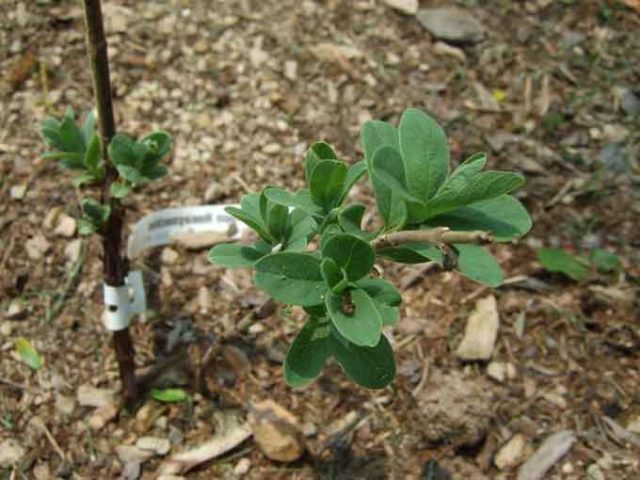
In autumn, lignified cuttings do not germinate, but root with the onset of spring
An annual lignified growth with a thickness of 1 cm or more is cut in the fall.Cuttings are cut 20 cm long so that each has 5 internodes. For storage, the prepared material is sent to the cellar, wrapped in burlap or covered with sand, sawdust. Be sure to remember to carry out the fungicide treatment to prevent the development of the fungus.
Breeding begins only in the spring. The prepared substrate is moistened, treated with fungicides against rot. The workpieces are immersed in the ground at an angle of 45 °, keeping a distance of about 12 cm. In the south, they can be planted directly on the street. For cold regions, it is optimal to use nurseries.
After deepening the lignified twig, one bud should remain above the ground. A greenhouse is being built over the plantings. Rooting will occur around the third week. Honeysuckle seedlings growing on the street are freed from the greenhouse. If a nursery was used, then before planting in open ground, the plants are hardened.
How to cut honeysuckle cuttings
The cutting of the planting material is performed with a sharp secateurs. If breeding occurs in summer, the green twigs can be cut off with a sharp knife. In any case, the instrument must be disinfected before use.

Green twigs are easier to cut with a knife
Green shoots are cut in the early morning or afternoon if the weather is cloudy. The length of the workpiece is from 7 to 12 cm. There must be at least three internodes with full buds and leaves. The leaf is cut off from below, and the rest are cut off with scissors by 50%. With a lower oblique cut, the twigs are immersed for a day in a solution with any drug to stimulate root growth.

Lignified branches of honeysuckle are cut with pruning shears
Stocking up with lignified cuttings is available, if desired, in the spring before the buds swell or in the fall after the foliage is shed. In the second option, this is the period from September to October, which depends on the weather conditions in the region. The twigs are used ripe, of the current year. Each workpiece should have from 3 to 5 internodes.
When harvesting in spring, it is enough to cut short cuttings up to 12 cm long with three internodes. The upper cut is made 5 mm higher from the kidney at a right angle. The lower cut is oblique at a distance of 15 mm from the kidney. Autumn cuttings are cut according to a similar principle, only their length is up to 20 cm, and there are five internodes.
How to root honeysuckle cuttings
For propagation of the berry, two methods of rooting blanks are used. The easiest way is to germinate honeysuckle cuttings in water before planting them in the ground.

When germinating in water, you can see which branch has taken root, and which will not work
Immediately after cutting the green blanks with the lower oblique cut, they are placed in any container, for example, a jar. Pour in some water. To stimulate root growth, you can add "Kornevin". As the liquid evaporates and absorbs the branches, a little water is added. When roots about 2 cm long appear, the blanks are transplanted into the ground.

Germination in the substrate allows you to immediately get a ready-made seedling
The second method of rooting is based on immersing the blanks directly into the substrate. It is possible to plant green shoots using this method, but most often it is used for lignified blanks. Oblique cuts of cuttings are treated with "Kornevin", immersed in the soil in the garden bed or in the nursery. Set up a greenhouse. The soil is kept moist at all times. Condensation droplets on the shelter testify to a good microclimate. After the sprouts appear, the honeysuckle seedlings begin to harden, opening the shelter for a short time. Over time, the greenhouse is removed, and the amount of watering is reduced.
Useful Tips
Honeysuckle is considered an unpretentious berry crop. Even with its reproduction, the gardener should not have any problems. In order for the process to be successful, the berry tree bore fruit well, it is important to listen to several recommendations:

Honeysuckle doesn't give the grower a lot of trouble
- With this method of reproduction, it is necessary to make blanks from shrubs of various varieties. At least 3 types are desirable. Honeysuckle does not bear fruit without the neighborhood with edible varieties.
- For planting rooted seedlings, choose a sunny place.
- It is better to plant seedlings not in rows, but in a curtain. This arrangement is more attractive to pollinators.
- For cuttings, healthy honeysuckle bushes are used without visible signs of disease and damage by pests.
And what is also desirable to do is a good hardening of the seedlings before planting in a permanent place.
Conclusion
The method of propagation of honeysuckle by cuttings is chosen by the gardener for himself the one that he likes best and is suitable for the climatic conditions of the region. The best survival rate is observed for material harvested in spring or summer. Some of the autumn twigs may disappear during the winter if the storage technology is violated.



